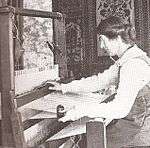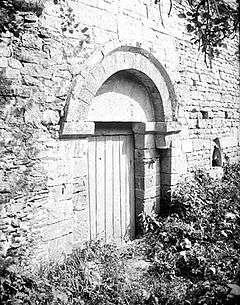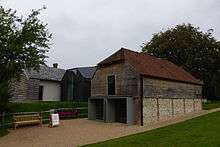Ethel Mairet
| Ethel Mairet | |
|---|---|
 | |
| Born |
Ethel Mary Partridge 17 February 1872 Barnstaple, Devon, England |
| Died |
18 November 1952 (aged 80) Ditchling, East Sussex, England |
| Nationality | British |
| Other names | Ethel Coomaraswamy |
| Known for | Hand loom weaving designer |
Ethel Mary Partidge, Ethel Mary Mairet RDI, or Ethel Mary Coomaraswamy (17 February 1872 – 18 November 1952) was a British hand loom weaver, significant in the development of the craft during the first half of the twentieth century.[1]
Life
Ethel Mary Partridge was born in Barnstaple, Devon, in 1872. Her parents were David (a pharmacist) and Mary Ann (born Hunt) Partridge. She was educated locally and in 1899 she qualified to teach piano[2] at the Royal Academy of Music. She then took up work as a governess.
Introduction to textiles

She met the famed art historian and geologist Ananda Coomaraswamy, a wealthy Hindu man of Anglo-Ceylonese heritage.[4] The couple married on 19 June 1902 and traveled to Ceylon (now Sri Lanka), where he conducted a mineral survey. They returned to England in 1907 and published their investigations into Ceylon crafts.[4]
Until 1910 they lived in Broad Campden[4] where the arts and crafts architect Charles Robert Ashbee had established a community of artists and craftspeople. This Guild and School of Handicraft in Chipping Campden included Ethel's brother Fred Partridge[5], a jeweller. Ashbee renovated a Norman chapel as the Coomaraswamy home. The couple visited India, where they added to the textile collection they had begun whilst in Ceylon. Ethel learned how to weave by hand.[4]
Her husband met Alice Richardson, then still a teenager, when she visited her friend Philip Mairet in 1907.[6] Coomaraswamy began openly having an affair with her because he wanted a child he suggested that he should take her as his second wife. Ethel found this unforgivable.[6] Her husband committed himself to Alice Richardson and they were then married. Alice visited India with her new husband and returned as the musician Ratna Devi after embracing a Hindu lifestyle. Ethel went away alone and built a house near Barnstaple complete with studios for textile dyeing and weaving.[2]
Weaving and dying
In 1913 she married Philip Mairet, who was fifteen years younger than she was. Her second husband had been her first husband's secretary and he had also worked with Ashbee. Together they established a joint home and studio near Stratford upon Avon.
She was visited in 1914 by Mahatma Gandhi, who knew of her work in Ceylon and was interested in using simple textile techniques in India (see Khadi).[2]
Ditchling

In 1916 she visited Eric Gill and The Guild of St Joseph and St Dominic in Ditchling. Mairet was so impressed that she set about moving there.[4] In 1918 she published A Book on Vegetable Dyes.
During the 1930s and 1940s she trained people in weaving and dyeing at her Gospels studio at Ditchling. Mairet's seminal training at her workshop is said to have influenced all of the aspiring hand weavers of that generation.[7]
The Swiss weaver Marianne Straub came to work with her and to learn more about hand loom weaving[8]; Mairet taught Straub about hand dyeing and spinning as well. Straub introduced a variety of double cloth weaves and developed a friendship with Mairet.[9] Mairet learnt in turn from Straub and this underwrote her belief that hand loom weaving could be used by industry. Straub and Mairet went on three European holidays during the mid 1930s. Straub frequently returned to Mairet and Gospels.[9] A surviving journal written by Mairet from a European journey with her husband in 1927 illustrates how her observations were dominated not by whom she met but what they were wearing.[10]
A member of both the Red Rose Guild of Craftsmen and the Guild of Spinners, Weavers and Dyers, in 1937 she became the first woman awarded the Royal Society of Arts title of Royal Designer for Industry.[11] In 1939 she published Handweaving Today, Traditions and Change. She taught at the Brighton College of Art from 1939 until 1947.
Mairet remained active throughout her life, and continued mentoring pupils and sending examples of her oeuvre to schools across the country.
Legacy
Mairet died in Ditchling Common in 1952 and she was buried in Brighton,[2] at St Nicholas' churchyard.[12]
Mairet influenced a generation of weavers. The Oxford Dictionary of National Biography quotes the Japanese potter Shoji Hamada who called Mairet "the mother of English hand-weaving".[4] Ditchling Museum of Art and Craft exhibits artifacts related to Mairet and other artists who worked locally.[13]
She is the subject of a biography, A Weaver's Life: Ethel Mairet.[14]
The Ethel Mairet archive is housed at the Crafts Study Centre. It includes documents and memorabilia from 1872–1952. Personal documents, travel journals 1910–1938. business and personal letters, books of account and photographs are included[15] and are still (2015) a subject of academic study.[10]
Published works
- Mairet, Ethel M. (1916). A Book on Vegetable Dyes. Douglas Pepler at the Hampshire House Workshops, Hammersmith, gutenberg.org.
- Ethel Mairet (1939). Hand-weaving To-day, Traditions and Changes: By Ethel Mairet,... Faber and Faber.
References
- ↑ Robertsona, Kirsty (1 May 2015) [2005]. "Resistance and Submission, Warp and Weft: Unraveling the Life of Ethel Mairet" (PDF). Textile: The Journal of Cloth and Culture. 3 (3): 292–317. doi:10.2752/147597505778052486. Retrieved 20 October 2015. (subscription required)
- 1 2 3 4 Ethel Mairet Archived August 1, 2015, at the Wayback Machine., Brighton University, Retrieved 18 October 2015
- ↑ Norman Chapel House, British Listed Buildings, Retrieved 21 October 2015
- 1 2 3 4 5 6 Coatts, Margot (October 2007) [2004]. "Mairet, Ethel Mary (1872–1952)". Oxford Dictionary of National Biography. Oxford University Press. Retrieved 18 October 2015. (subscription required)
- ↑ C R Ashbee, Cheltenham Art Gallery and Museum, Retrieved 19 October 2015
- 1 2 Cages Entanglment. Edward Crooks, 1985, Pages=66–67, York University, Retrieved 20 October 2015
- ↑ Craft Study Centre Archived 2015-05-13 at the Wayback Machine., University Museum of Modern Crafts, Retrieved 18 October 2015
- ↑ Faculty portraits. "Dr Marianne Straub". brighton.ac.uk. University of Brighton. Retrieved 19 October 2015.
- 1 2 Coatts, Margot (1997). Pioneers of Modern Craft. Manchester: Manchester University Press. pp. 84–94. ISBN 0-7190-5058-8.
- 1 2 Ethel Mairet (2015) "Yugoslavian Journal, May 4–30, 1927", The Journal of Modern Craft, 8:1, 77–85
- ↑ "Ethel Mairet". University of Brighton Faculty of Arts. Retrieved 20 October 2015.
- ↑ julia&keld (19 March 2012). "Ethel Partridge Mairet". Find a Grave. Retrieved 20 October 2015.
- ↑ About Us Archived 2015-09-18 at the Wayback Machine., Ditchling Museum of Art and Craft, Retrieved 19 October 2015
- ↑ Coatts, Margot (August 31, 1983). A Weaver's Life: Ethel Mairet, 1872–1952 (Paperback)
|format=requires|url=(help). London Bath: Crafts Council in association with the Crafts Study Centre. ISBN 0903798700. ISBN 978-0903798709. - ↑ "The Ethel Mairet Crafts Study Centre. Reference Number(s) GB 2941 2003.21/2003.23". Archives Hub. Retrieved 20 October 2015.
External links
- Works by Ethel Mairet at LibriVox (public domain audiobooks)

